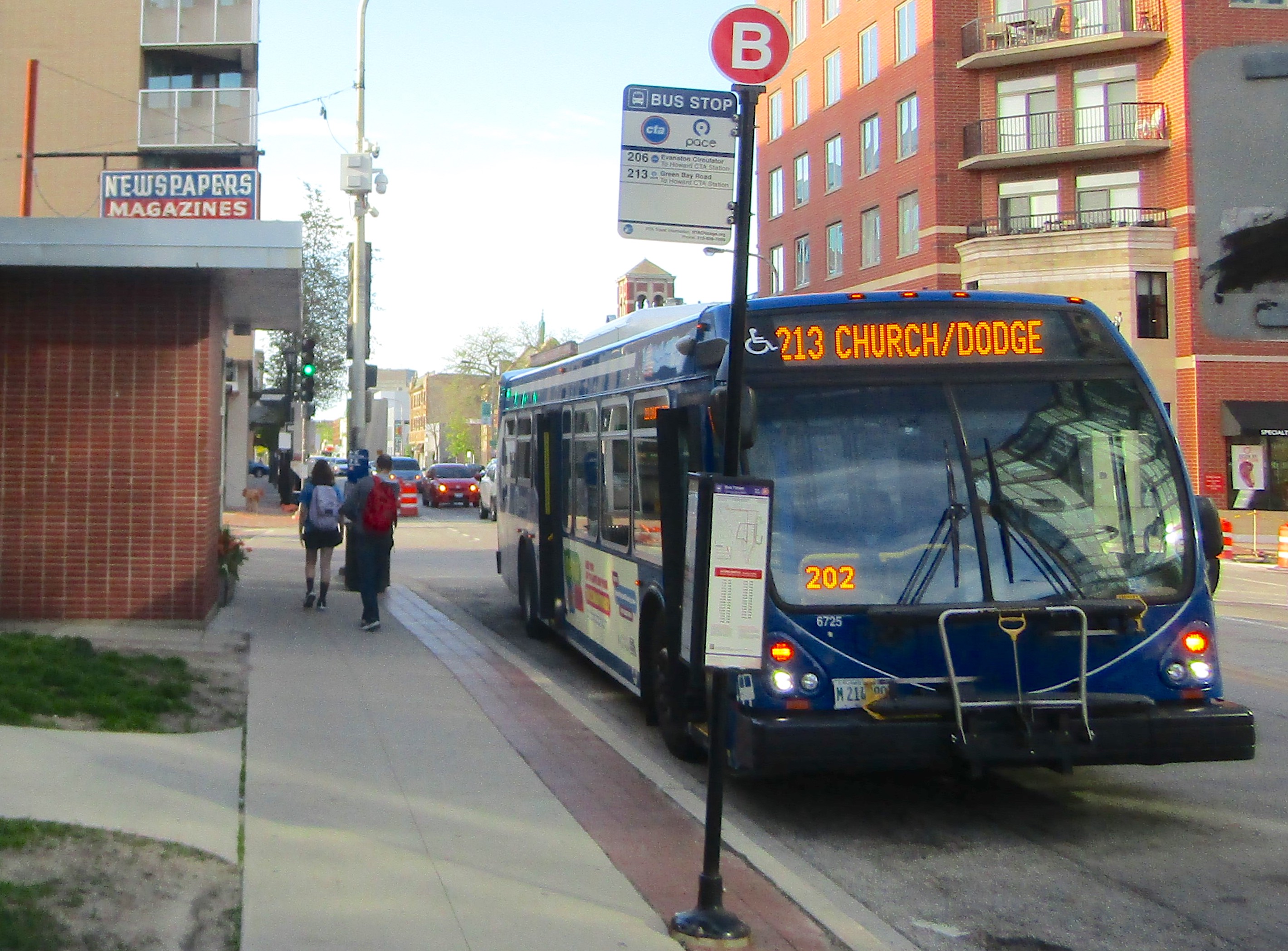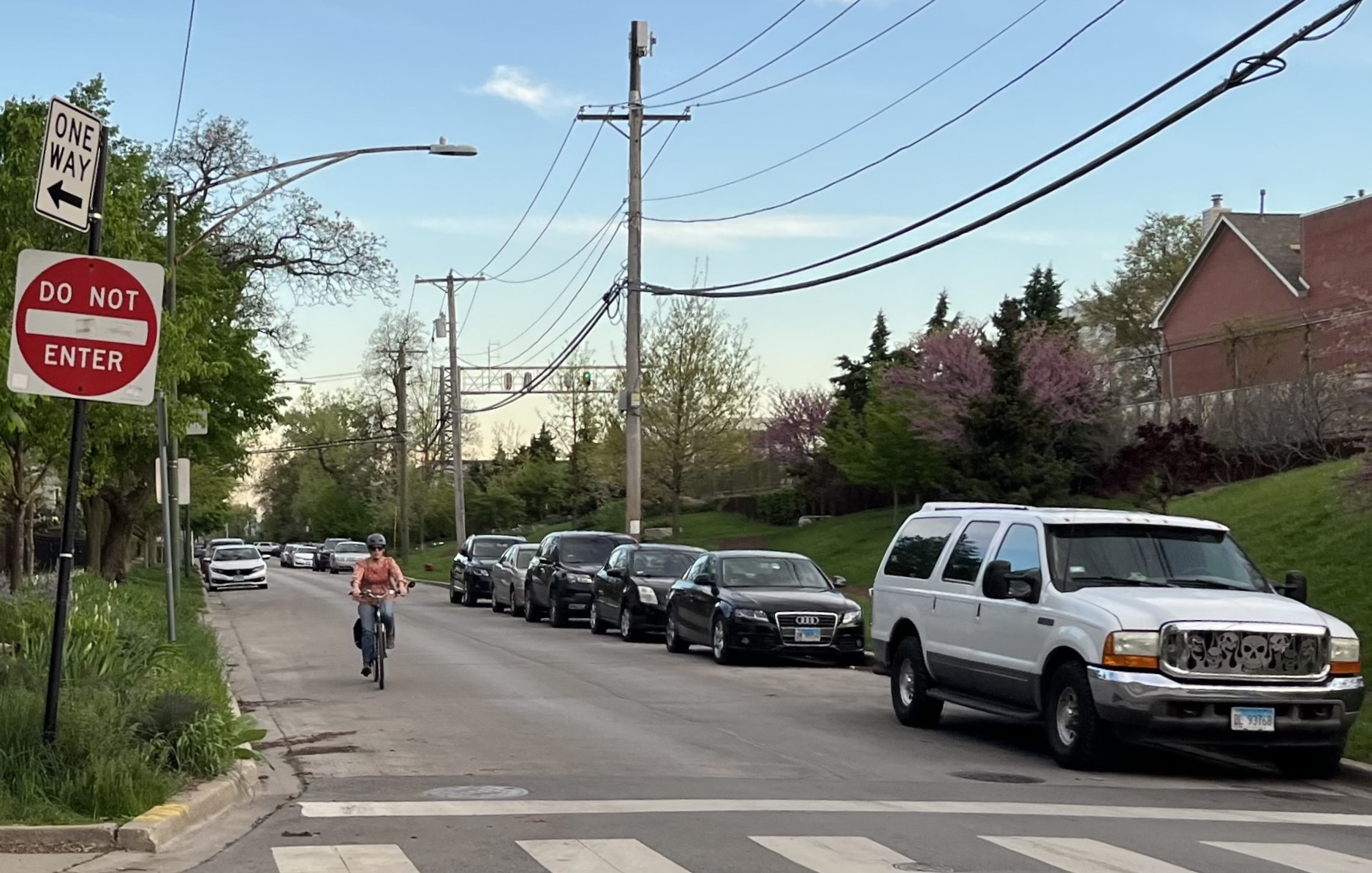Pace’s 2019 Budget Includes Service Reductions, Route Eliminations
8:13 PM CDT on October 31, 2018
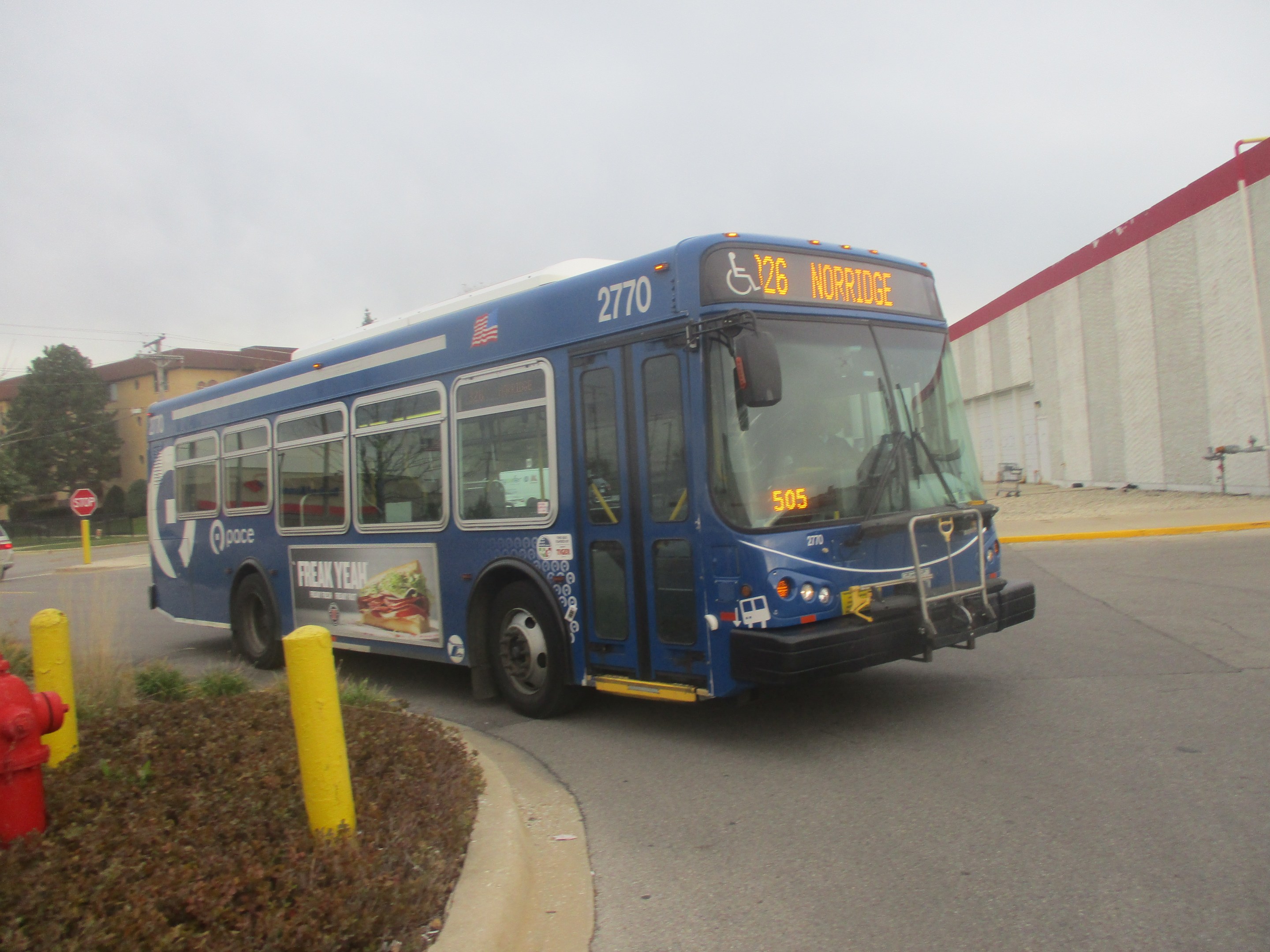
A Route 326 Pace bus at Norridge Commons. Photo: Igor Studenkov
Pace suburban bus transit’s proposed budget for next year doesn’t have any fare increases, like last year’s budget did. But the agency is looking to eliminate eight routes, take away Saturday service on five routes and get rid of the Round Lake Area Call-N-Ride service.
Pace estimates that, altogether, the service cuts would save $1.2 million, which would go toward $1.7 million in service enhancements. The agency intends to spend $1 million on the Milwaukee Pulse arterial rapid transit corridor, and use the remaining $700,000 to improve the system’s on-time performance. In a statement, Pace argued that most of the eliminated routes were low-performing and weren't expected to improve, and given the decline in state and federal funding, it needs to get the most it can out of the funds it has.
Pace's Board of Directors is expected to vote on the budget during its November 14 meeting. And while it isn't clear when the service cuts will take effect, the transit agency indicated that it would be some time before April 1, 2019.
In the initial press release announcing the proposed budget, Pace stated that it “worked to encourage ridership on these routes, however they are not performing to Pace’s standards and the agency can no longer support these routes without the necessary fare revenue.”
When asked what Pace’s standards were, spokesperson Maggie Daly Skogsbakken explained that it had to do with four performance targets: “productivity or passengers per revenue hour, operating subsidy per rider, farebox recovery ratio, and operating subsidy per vehicle mile”
“Each quarter, Pace identifies which routes do not meet at least two of the four performance targets,” she continued. “When routes fail to meet at least two of the four performance targets on a consistent basis, action needs to be taken to address the performance issue. These are not the only determining factors when considering restructurings, reductions or eliminations, but they are major factors.”
All of the fixed routes slated for elimination have rush-hour-orientated schedules that connect connect riders to Metra or ‘L’ stations. While routes 304 and 326 have buses traveling in both directions, the rest of the routes on the list are designed to drop passengers off at Metra stations in the morning and pick them up in the evening. Daly Skogsbakken said that those types of routes haven’t done too well in recent years.
“Changing commute patterns and irregular workdays have hit rush hour-only commuter routes especially hard,” she said. “Parking capacity at [transit] stations system-wide has also increased by 2.4 percent since 2008.”
Route 326 links together Norridge Commons shopping plaza shopping center and Rosemont Blue Line ‘L’ station, serving several hotels and convention centers in Rosemont. It stands out among the list for several reasons. Its average weekday ridership is significantly higher than any the others, averaging between 140-200 riders, and it is the only route that saw its ridership go up in 2018.
While there are some CTA and Pace routes that would cover the portions of the routing, Daly Skogbakken said that there was no alternative service for the route as a whole.
As for the rest, she pointed to their low ridership and said that, between the dial-a-ride services for seniors and people with disabilities, as well as some of the nearby fixed routes, riders would have alternatives.
Route 304 links together North Riverside Mall and the LaGrange Amtrak/BNSF Metra Line station, serving Riverside and Brookfield along the way. This year, it has seen only 50-80 riders a day, and the ridership has seen noticeable declines since 2012. Daly Skogsbakken noted that other routes in the area, such as routes 322, 330 and 331, would still be able to get riders to or near major destinations – even if it would require transfers.
Route 362 connects destinations throughout the Village of Park Forest to the Metra Electric Line's Richton Park station. This year, it saw a mere 25-32 daily riders. Daly Skogsbakken suggested Route 367, which serves portions of eastern Park Forest and Metra Electric's University Park station, as an alternative.
Route 661 connects portions of southwest Westmont to BNSF Metra Line Westmont station. This year, it has seen a measly 12-16 riders in day. Daly Skogsbakken noted that routes 463, 662, 715 serve some of the nearby areas and provide connections to either Westmont or Downers Grove BNSF line stations.
Route 681 connects northern Naperville with the Amtrak/BNSF Metra Line Naperville station. While the route saw 33-42 riders a day in January-May – only slightly smaller than the range for the previous two years – during the summer, the numbers dropped dramatically to 17-18 riders. Daly Skogsbakken noted that routes 676 and 714 overlap in some of the areas, and both connect to the Naperville station.
Routes 824 and 825 serve similar niches, providing a link between destinations in western and eastern portions of Bollingbrook, respectively, and Metra's BNSF Line’s Lisle station. But while Route 824 has seen an average ridership of 11-16 riders, Route 825 has seen 29-40 riders.
Daly Skogsbakken said that, aside from Route 825, riders may be able to use Route 834, which serves the area’s busier streets and connects to Downers Grove BNSF Metra Line station, which is located two stops to the east of Lisle station. She also noted that riders can take express route 850 directly to downtown Chicago.
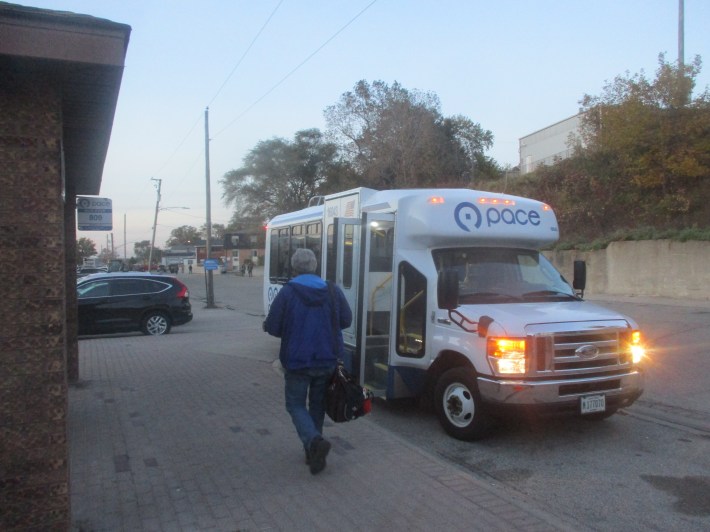
McHenry County Cut
Route 809 was originally unveiled in February 2015 to connect the Village of Richmond to Metra's Milwaukee District-North Line’s Fox Lake station. The transit agency has less fixed route service in McHenry County than any other county in RTA service area. The fact that the county is more rural in character than other local counties is a factor. At the time, Pace described the new route as an important link for commuters, allowing riders to not only transfer to Metra, but to connect to routes servicing nearby portions of McHenry and Lake Counties.
But in the past three years, the ridership has been in single digits, and it has shown no signs of increasing. Daly Skogsbakken said that Pace believes that one of the major reasons why Route 809 didn’t catch on was the fact that parking at Fox Lake station was cheaper than the Pace fare. According to the Village of Fox Lake's website, the 30-day station parking pass is $30 – half the cost of Pace's 30-Day pass. But the schedule may have also been a factor. The morning buses leave downtown at 5:53 a.m. and 6:23 a.m. to allow riders to catch trains that arrive in downtown Chicago at 7:23 a.m. and 8:18 a.m., respectively. However, there are several morning trains that leave Fox Lake station later and still arrive in Chicago before 9:00 a.m.
A Route 809 bus driver who declined to give her name told me that while Route 809 was aimed at workplace commuters, at least one of its regular riders didn’t use it this way.
“I got one guy from Woodstock, who catches 806 to catch 807 to catch 809,” she said. “He lives in Woodstock, and his girlfriend lives in Richmond. He is very upset. He said he’ll go to [Oct. 25 Pace public hearing in McHenry County] to complain.”
Daly Skoggsbakken said that MCRide, a dial-a-ride service operated by Pace and available to general public, is an alternative. However, while Route 809 charges the usual Pace fare of $2.00 a trip, MCRide charges $2.50 for the first first five miles and $0.25 for each additional mile. Given that the distance between Fox Lake and Richmond is about 10 miles, that would mean riders would have to pay $3.75 each way – or $225 over 30 days.
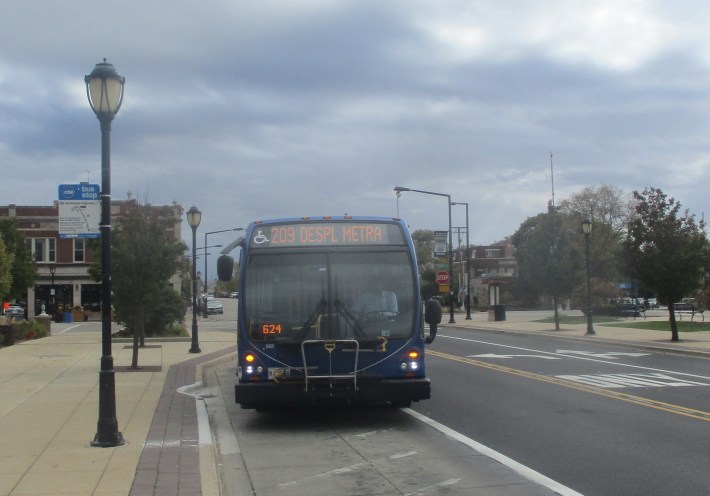
Other Service Reductions
In addition to the fixed route, Pace is proposing to eliminate Round Lake Call-n-Ride service, which is designed to cover parts of the service area in northern Lake County, between Monaville Road, IL 83 and US 45 highways, Belvedere Road, Railroad Avenue and Cedar Lake Road. As Daly Skoggsbakken noted, Pace routes 570, 572 and 574 would still serve the major corridors within the service area – though area north of Rollins Road wouldn't have any service.
Five routes would have their Saturday service cut. Route 209 serves Chicago’s Norwood Park neighborhood and cities of Park Ridge and Des Plaines, while Route 348 serves Harvey, Dolton, Riverdale, Calumet Park and Blue Island, and Route 504 serves southeastern portions of Joliet. In the western suburbs, Route 540 serves Farnsworth Avenue corridor in Aurora, while Route 546 serves southwestern Elgin.
In the initial press release, Pace indicated that the money from the service cuts would be “reinvested to enhance service.” Daly Stoggbacken said that the transit agency is still trying to nail down what that would entail.
“We do not have a final list of enhancements, but my understanding is that they will focus on improving on-time performance,” she said. “If this proposed budget is accepted, we will prioritize improvements implement as many [improvements] as we can.”
![]()
Did you appreciate this post? Consider making a donation through our PublicGood site.
Read More:
Stay in touch
Sign up for our free newsletter
More from Streetsblog Chicago
Since COVID, Pace ridership has fared better on major corridors and in north, northwest suburbs than in south, west ‘burbs
The suburban bus system's top five busiest routes largely maintained their ridership rankings.
Due to incredible support from readers like you, we’ve surpassed our 2023-24 fundraising goal
Once again, the generosity of walk/bike/transit boosters is fueling our reporting and advocacy.
Which Metra corridor would become more bike-friendly and greener under a new plan? Ravenswood!
Thanks to plans to convert little-used parking spaces, the avenue is slated to get a new bike lane, and the Winnslie Parkway path and garden will be extended south.
